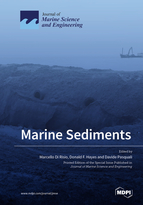Marine Sediments: Processes, Transport and Environmental Aspects
A special issue of Journal of Marine Science and Engineering (ISSN 2077-1312).
Deadline for manuscript submissions: closed (15 January 2020) | Viewed by 17000
Special Issue Editors
Interests: coastal engineering; ocean engineering; environmental engineering; water waves hydraulics; physical modeling
Special Issues, Collections and Topics in MDPI journals
Interests: environmental engineering; costal engineering; contaminated sediment management; environmental dredging; beneficial use of sediments; water resource system optimization; computer modeling
Interests: storm surge forecasting; coastal engineering; ocean engineering; environmental engineering; water waves hydraulics; physical modeling; wave energy
Special Issues, Collections and Topics in MDPI journals
Special Issue Information
Dear Colleagues,
In recent years, increasing attention has been paid to water quality and environmental aspects related to sediment transport driven by both ambient forcing and human activities. Indeed, estuarine, coastal, and harbor areas often undergo operations to nourish beaches, to maintain navigation channels, to remove contaminated sediment, and so forth. Hence, much research is needed related to the sediment processes, transport, and related environmental aspects of marine sediments. The aim of this Special Issue is to collect novel research results in this field.
Authors are invited to submit papers dealing with topics including but not limited to the following:
- marine sediment processes, transport, and environmental aspects related to dredging operations
- coastal sediments transport
- harbor siltation
- sustainable coastal defence systems
- contaminated sediment management
Research based on field observation, numerical and experimental modelling, and theoretical models is expected to be part of the Special Issue. Also, methodological approaches, comprehensive reviews, and best practices on national and international scales are welcome.
Prof. Dr. Marcello Di Risio
Prof. Dr. Donald F. Hayes
Dr. Davide Pasquali
Guest Editors
Manuscript Submission Information
Manuscripts should be submitted online at www.mdpi.com by registering and logging in to this website. Once you are registered, click here to go to the submission form. Manuscripts can be submitted until the deadline. All submissions that pass pre-check are peer-reviewed. Accepted papers will be published continuously in the journal (as soon as accepted) and will be listed together on the special issue website. Research articles, review articles as well as short communications are invited. For planned papers, a title and short abstract (about 100 words) can be sent to the Editorial Office for announcement on this website.
Submitted manuscripts should not have been published previously, nor be under consideration for publication elsewhere (except conference proceedings papers). All manuscripts are thoroughly refereed through a single-blind peer-review process. A guide for authors and other relevant information for submission of manuscripts is available on the Instructions for Authors page. Journal of Marine Science and Engineering is an international peer-reviewed open access monthly journal published by MDPI.
Please visit the Instructions for Authors page before submitting a manuscript. The Article Processing Charge (APC) for publication in this open access journal is 2600 CHF (Swiss Francs). Submitted papers should be well formatted and use good English. Authors may use MDPI's English editing service prior to publication or during author revisions.
Keywords
- marine sediment
- contaminated sediment management
- coastal sediment transport
- harbor siltation
- dredging
- water quality
- coastal engineering
- coastal defence system
- mathematical modelling
- engineering practice








